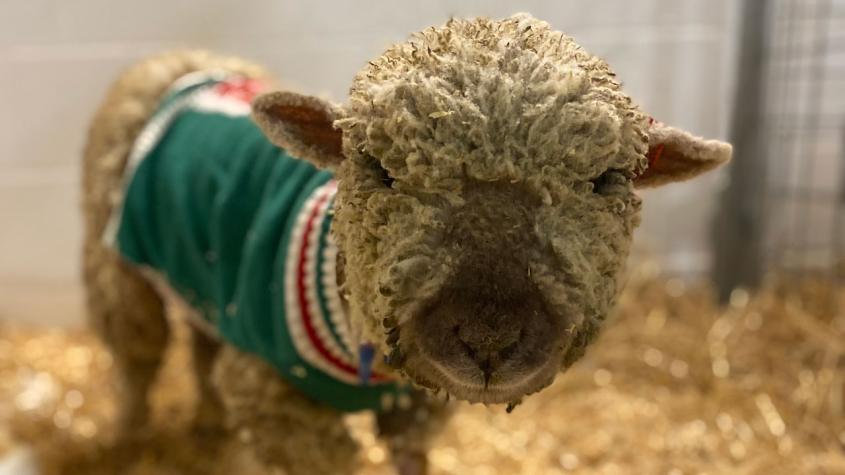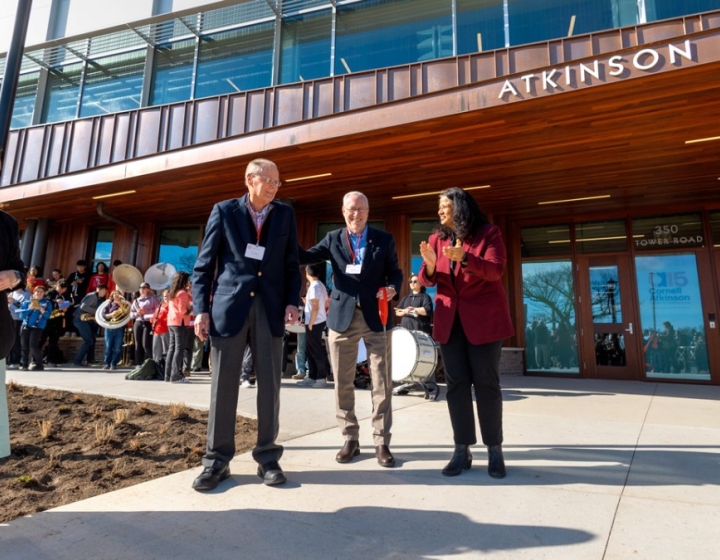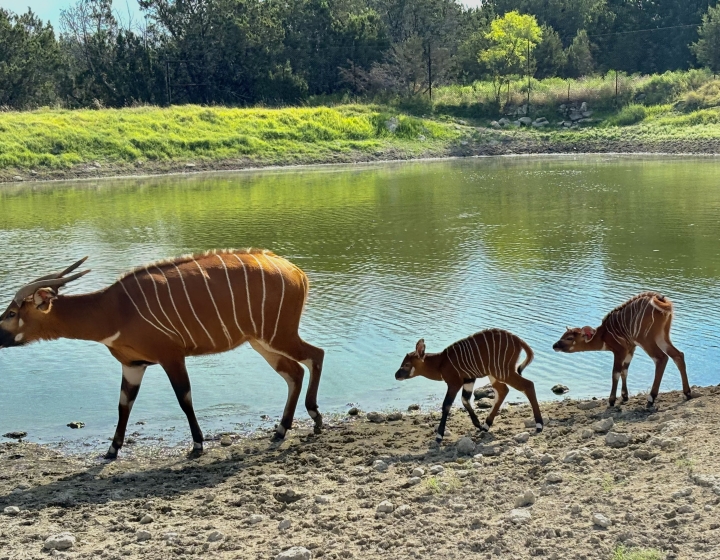Once unable to swallow, sheep’s congenital throat defect repaired with novel approach
A team of Cornell veterinarians successfully repaired a rare congenital defect affecting the vessels around the esophagus of a sheep using a minimally-invasive technique – the first time this method has been used in large animals. Not only did this procedure save the sheep’s life, but it opens the door to treating other large animals with this congenital defect.
Petey the sheep was born with a vascular ring anomaly, an embryonic vessel that turned into a ligament which wrapped around his esophagus, preventing him from swallowing. As a result, he was malnourished and his growth was stunted. To fix the problem, a team of Cornell veterinarians used a scope and minimally-invasive surgical tools to dissect the ligament from the esophagus and then cut it.

“I’m proud of the procedure because it brought together so many specialists from the small and large animal medicine sides,” said Dr. Nicole Buote, associate professor of small animal surgery and the lead surgeon on the case. “Everyone worked together and did their job, which allowed us to push boundaries and advance animal medicine.”
Buote, an expert in minimally-invasive surgery, typically performs this procedure in dogs.
Four other Cornell veterinarians worked on the case. Dr. Katharyn Mitchell, chief of large animal internal medicine, initially learned about Petey’s case on an academic veterinary listserv. She coordinated the team and looked after Petey before and after surgery, while assisting in surgery by shining an endoscopic light down Petey’s esophagus that allowed the team to see the constriction clearly.
Dr. Eileen Hackett, professor of large animal surgery, provided her expertise in minimally-invasive surgical techniques on sheep. Dr. Peter Scrivani, associate professor of diagnostic imaging, reviewed the imaging studies that allowed the Cornell team to identify the defect and plan the surgery. And Dr. Stephanie Hon, assistant professor of anesthesiology, managed the anesthesia for the surgery, which involved purposely collapsing part of Petey’s lungs to improve the field of vision for the surgeons.
Before the procedure, the team was not completely confident about Petey’s chances for recovery because veterinary literature reported that previous surgeries for this defect in alpacas resulted in many complications. But the minimally-invasive techniques made a big difference for Petey, Mitchell said.
“Because of our minimally-invasive approach, his recovery was extraordinarily smooth,” she said. “It was remarkable how quickly he recovered from anesthesia, and his lung recovered from the collapse. The biggest problem we had was stopping him from overeating!”
After the surgery, the Cornell team built a special raised box to elevate Petey’s head while he ate. They had to use a muzzle to prevent him from eating his straw bedding.

Petey is a babydoll wether sheep from the Avalon Nature Preserve, a 216-acre preserve in Stony Brook, New York that includes a restored farm. Preserve Director Kathy Griffiths noticed Petey’s struggles to swallow and gain weight after he was weaned. She reached out to a professor at the Tufts School of Veterinary Medicine, who examined Petey and posted his case on the listserv.
“We brought him home with a modified diet, but the prognosis wasn’t great,” Griffiths said. “When Cornell reached out to say they may be able to help, we figured was the best way to give him a fighting chance. We also really liked the idea of possibly helping other animals down the line.”
The Cornell veterinary team is writing up Petey’s case for a journal article in the hopes they will be able to help other large animals – particularly foals – with this defect in the future. Typically, foals with this defect are euthanized.
“This really was a perfect storm of a wonderful owner who had the financial means to do this, and a dream team here,” Buote said. “It’s our hope now that more people will know this is possible and it has a good outcome.”
In the meantime, Petey has fully recovered and rejoined his flock at the nature preserve. “By all visual signs, he is thriving,” Griffiths said.
That’s exactly the outcome the Cornell team was hoping for. “Petey is extremely lucky that his owners were motivated to get a diagnosis and provide a solution,” Mitchell said. “This was an opportunity to help a young animal have a normal life. It’s an exciting for us to be able to intervene early and make a difference.”
Written by Sheri Hall





